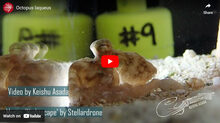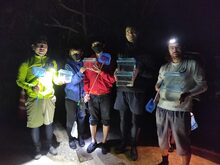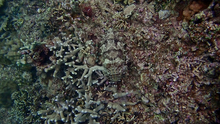Posts
Join Reiter Unit as a Global Science Scholar postdoctoral fellow!
Reiter Unit is honored to have been selected as one of the hosts for this unique postdoc fellowship program, Sponsored by the Chan Zuckerberg Initiative (CZI) and the Japanese Cabinet Office.
Apply and join Reiter Unit as a Global Science Scholar!
Program Overview
Octopus laqueus
Introducing Octopus laqueus, a small nocturnal octopus that was discovered in Okinawa. It is being used at the Computational Neuroethology Unit (Prof Sam Reiter), to study active sleep, the results of which were published in the journal Nature in June 2023.
Octopus incella
Octopus incella is an octopus that was discovered in Okinawa, and can be seen among the tidepools at night. It is currently being cultured by Reiter Unit and the Animal Resources Section, with the third lab-grown generation being reared in 2023. It's the first octopus species to have a closed life cycle at OIST and the first time it has been done with this species.
What kind of orange tree is this?
The Starry Night Octopus (Callistoctopus luteus) can be seen in a variety of biomes after the sun goes down. Here, one swims up to show what might be a threat display, as if challenging the bright and confusing lights.
A cooperative model
The Broadclub Cuttlefish (Sepia latimanus) is sometimes a shy animal, but sometimes they don't seem to mind being watched up close.
Squid against the surge
Bigfin Reef Squid (Sepioteuthis lessoniana) are common across Okinawan waters. Often they are schooling just underneath the surface, sometimes right up against where the waves hit the rocky shores.
A slow reveal
Abdopus is a genus of octopuses often seen in shallow waters around Okinawa. They have some of the best camouflage out of all local cephalopods. Here, an Abdopus slowly reveals itself with the threat display when it realizes it's been seen.
サメハダテナガダコの威嚇
沖縄の海で夜に見られる代表的なタコの一つ。ダイバーの明かりに警戒し、姿勢を高くして身体を大きく見せ、かかってくる物を掴めれるように腕を上げている。
クワイカの密かな産卵
アオリイカの仲間である雄のクワイカが珊瑚の下のふさわしい穴を調べ、そこに素早く産卵する雌を覆うようにして守る。かつてアオリイカ(学名 Sepioteuthis lessoniana)は一つの種と考えられていたが、今は少なくとも3種に分かれていると知られている。まだ科学的な学名は与えられていないものの、沖縄ではシロイカ、クワイカ、アカイカとそれぞれ別の名前がつけられている。珊瑚や岩の下に卵を産む習性は他の2種と違うクワイカの特徴の一つである。
目の前に隠れているタコ
サンゴ礁に目がついている?何もいないようでも、目の前に隠れているものに覗かれながら、気付かずに通過することがよくあるでしょう。これは見晴らしの良いところに座り込んで擬態したワモンダコ。沖縄のサンゴ礁では最大で、(見えれば)最も多く見られるタコです。
Rearing octopus hatchlings
Octopuses, like other cephalopods, are quite difficult to sex due to lack of any external distinguishing characteristics. A trained eye may be able to spot the hectocotylus arm of the males – a specialized reproductive arm used to deliver spermatophores to the females. Additionally, females tend to be larger than males among most species. However, this can be quite ambiguous due to the different ages of the animals.
Octopus Catching
On the 12th of December, members of the Reiter Unit and the Cephalopod Care Team assembled at 10pm on the shores of Okinawa. After waiting several weeks for the stormy weather to clear up, we finally had the perfect weather and the low tide we needed for catching some octopuses. Geared up in our water shoes and armed with nets and torches we started our fieldwork with reef walking along the shore.
AMICUS Student Presentation
On the 12th of January, several OIST researchers presented their work to local middle school students from Okinawa AMICUS International. Sen, a member of the Computational Neuroethology Unit, also presented her work with the octopuses. The students learned about the different behaviors and body patterns exhibited by these animals and were fascinated by their learning and memory capabilities.
New Logo!
Thank you to Sofia Jain for the design.
Check out more of her work at https://www.wiseart.net/
New paper! Visual Perception and Cuttlefish Camouflage
Sam and Gilles' paper is out in Current Opinion in Neurobiology!
Image by Stephen Junek.










